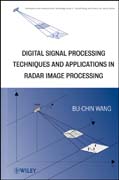
Digital signal processing techniques and applicationsin radar image processing
Wang, Bu-Chin
Digital signal processing (DSP) is the study of signals in a digital representation and the processing methods of these signals. Using radar imaging as an example, this book describes DSP principles and demonstrates how tools like MATLAB can solve DSP problems in real-life applications. It covers the development of new hardware and system architectures, and provides flowcharts, system block diagrams, and programs to apply DSP principles to Radar Imaging Processing algorithms. This comprehensive guide will appeal to a wide range of graduatestudents and engineering, communication, and systems professionals. INDICE: Preface Chapter 1: Signal Theory and Analysis. 1.1 Special Functions Used in Signal Processing. 1.2 Linear System and Convolution. 1.3 Fourier Series Representation of Periodic Signals. 1.4 Non-Periodic Signal Representation by Fourier Transform. 1.5 Fourier Transform of a Periodic Signal. 1.6 Sampling Theory and Interpolation. 1.7 Advanced Sampling Techniques. 1.7.1 Samplingwith Passband Signal. 1.7.2 Resampling by Evenly Spaced Decimation. 1.7.3 Resampling by Evenly Spaced Interpolation. 1.7.4 Resampling by Fractional Rate Interpolation 1.7.5 Resampling from Unevenly Spaced Data. Chapter 2: Discrete Time and Frequency Transformation 2.1 Continuous and Discrete Fourier Transform 2.2 Key Properties of Discrete Fourier Transform 2.2.1 Shifting and Symmetry 2.2.2 Linear and Circular Convolution 2.2.3 Sectioned Convolution 2.2.4 Zero Stuffing and DFT resolution 2.3 Windows and Discrete Fourier Transform 2.4 Fast Fourier Transform 2.5 Discrete Cosine Transform 2.6 Continuous and Discrete Signals in Time and Frequency Domain 2.6.1 Graphic Illustration of DFT 2.6.2 Resampling with Fractional Interpolation Based on DFT. Chapter 3: Basics of Antenna Theory 3.1 Maxwell and Wave Equations 3.2 Radiation from an Infinitesimal Current Dipole 3.3 Radiation from a Half-Wavelength Dipole 3.4 Radiation from aLinear Array 3.5 Power Radiation Pattern from a 2-D Rectangular Array 3.6 Fundamentals of Antenna Parameters 3.7 Commonly Used Antenna Geometries 3.7.1 Single Element Radiators 3.7.2 Microstrip Antennae and Antenna Array. Chapter 4: Fundamentals of Radar 4.1 Principles of Radar Operation 4.2 Basic Configuration of Radar 4.3 The Radar Range Equation 4.4 Cross Section and Clutter 4.5 Doppler Effect and Frequency Shift 4.6 Radar Resolution and Ambiguity Function. Chapter 5: Radar Modulation and Target Detection Techniques 5.1 Amplitude Modulation (AM) Radar 5.1.1 Continuous-Wave (CW) Radar 5.1.2 Pulse-Modulation Radar 5.2 Target Detection Techniques of AM Based Radar 5.2.1 Doppler Frequency Extraction 5.2.2 Motion Direction Detection 5.3 Frequency Modulation (FM) Radar 5.3.1 Pulsed LFM Radar 5.3.2 Continuous Wave Linear Frequency Modulation (LFM-CW) Radar 5.3.3 Stepped Frequency Modulation (SFM) Radar 5.4 Target Detection Techniques of FM-based Radar 5.4.1 In-phase Quadrature-phase Demodulator 5.4.2 Matched Filter and Pulse Compression 5.4.3 Target Detection Techniques of LFM Radar 5.4.4 Target Detection Techniques of SFM Radar Chapter 6: Basics of RadarImage 6.1 Background 6.2 Geometry of Imaging Radar 6.3 Doppler Frequency and Radar Image Processing 6.3.1 Broadside SAR 6.3.2 SAR with Squint Angle 6.3.2.1SAR with a Small Squint Angle 6.3.2.2 SAR with a Low Squint Angle 6.4 Range Migration and Curvature 6.5 Geometric Distortions of the Radar Image 6.6 Resolution of Radar Image. Chapter 7: System Model and Data Acquisition of SAR Image7.1 System Model of Range Radar Imaging 7.1.1 System Model 7.1.2 Reconstruction of Range Target Function 7.2 System Model of Cross-Range Radar Imaging 7.2.1 Broadside Radar case 7.2.1.1 System Model 7.2.1.2 Principle of Stationary Phase 7.2.1.3 Spatial Fourier Transform of Cross-range Target Response 7.2.1.4 Reconstruction of Cross-Range Target Function 7.2.2 Squint Radar Case 7.2.2.1 System Model 7.2.2.2 Spatial Fourier Transform of Cross-range Target Response 7.2.2.3 Reconstruction of Cross-Range Target Function 7.3 Data Acquisition, Sampling and Power Spectrum of Radar Image. Chapter 8: Range-Doppler Processing on SAR Image 8.1 SAR Image Data Generation 8.2 Synthesis of a Broadside SAR Image Data Array 8.2.1 Single Target Case 8.2. 2 Multiple Targets Case 8.3 Synthesis of a Squint SAR Image Data Array 8.3.1 Single Target Case 8.3.2 Multiple Target Case 8.4 Range-Doppler Processing on SAR Data 8.4.1 Range Compression 8.4.2 Corner Turn 8.4.3 Range Cell Migration Correction 8.4.4 Azimuth Compression 8.5 Simulation Results 8.5.1 Broadside SAR with Single Target 8.5.2 Broadside SAR with Multiple Targets 8.5.3 Squint SAR with Single Target 8.5.4 Squint SAR with Multiple Targets. Chapter 9: Wavenumber Processing on SAR Image 9.1 Wavenumber Domain Processing on SAR Data 9.2 Direct Interpolation from Unevenly Spaced Samples 9.3 Stolt Interpolation Processing on SAR Data 9.3.1 System model of Broadside SAR with Six Targets 9.3.2 Synthesis of Broadside SAR Data Array 9.3.3 Simulation Results 9.3.4 System Model of Squint SAR with Six Targets 9.3.5 Synthesis of Squint SAR Data Array 9.3.6 Simulation Results 9.4 Reconstruction of Satellite Radar Image Data 9.5 Comparison between Range-Doppler and Stolt Interpolation on SAR Data Processing
- ISBN: 978-0-470-18092-1
- Editorial: John Wiley & Sons
- Encuadernacion: Cartoné
- Páginas: 376
- Fecha Publicación: 05/09/2008
- Nº Volúmenes: 1
- Idioma: Inglés
